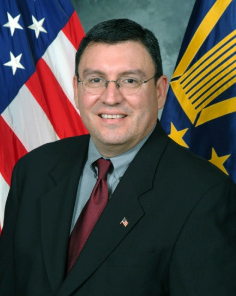

Alfred Rivera, who retired after serving more than 20 years at the Defense Information Systems Agency, said DoD can’t underestimate the costs and time it takes to...
Best listening experience is on Chrome, Firefox or Safari. Subscribe to Ask the CIO’s audio interviews on Apple Podcasts or PodcastOne.
The Defense Department isn’t creating a new path with its desire to move to the commercial cloud.
In many ways, the Defense Information Systems Agency already took on a similar project with its MilCloud program.
Alfred Rivera, who retired after serving more than 20 years at the Defense Information Systems Agency, including most recently as the director of the development and business center, said the Joint Enterprise Defense Infrastructure (JEDI) cloud program should under the experiences of the MilCloud’s first three-plus years.
“The concepts and ideas of a cloud offering to quickly support meeting mission requirements and be responsive to the mission partner is a great objective and goal,” said Rivera, who now is a principal for Breakwater Solutions, an acquisition and technology strategy consulting company. “What I hope for and I hope they continue to review and seek out as this acquisition goes forward is to recognize that I don’t think one-size fits all for the DoD. One of the things I’m really concerned about is the DoD is a heterogeneous environment and I don’t think one-size-fits-all.”

Rivera said DISA tried to standardize across a single foundational architecture with its cloud efforts, including Milcloud 1.0.
“There was a lot of mission partners that still didn’t seamless migrate to Milcloud 1.0 easily,” Rivera said on Ask the CIO. “Those that lived in the legacy world had a large challenge in trying to make their solutions cloud enabled. Those who were already in a later state of architecture, they were using different middleware, different platform-as-a-service solutions so trying to bring them into a foundational architecture just wasn’t always successful.”
DoD released the draft request for proposals for JEDI on March 7 and is accepting comments through March 21. During a recent industry day, DoD struggled to clarify its goals and plans for JEDI, according to vendors attending the event.
Under JEDI, DoD wants to make it easier for the services and agencies to move to a commercial cloud provider. What’s unclear is whether DoD is looking for one cloud provider or a series of providers under a cloud broker or system integrator model.
This is why the lessons of MilCloud are so important for the success of JEDI.
Rivera said none of DISA’s customers decided not to move to MilCloud 1.0 because of these challenges, but it did slow down and make migrations more costly.
“You have to get to some kind of foundation or basis, especially if you are going to get some economic savings,” he said. “What the challenge is, and I experienced it for many years with MilCloud 1.0 and we will experience it with MilCloud 2.0, not everyone fits into that single foundation. So supporting the migrations of moving customers to either a finite set of foundations is still going to be a challenge. There are customer who have legacy applications out there that are not even cloud enabled or cloud ready, and there are some that are close to it, but are not using the same architecture or framework. There may be some work to help them move to it. That is where the win is, regardless whether it’s JEDI or the current cloud implementation, how can that customer understand how to move that application.”
Rivera said among the biggest challenges DISA found with moving applications to MilCloud 1.0 included the distributed nature of the functions, particularly at the presentation and database layers.
“How do you pull all those together into a cloud is a challenge,” he said. “Enterprise resource planning applications are an example of that. As we start looking at ERP applications for these large back-end business systems and large back-end office applications, how they are distributed and built initially will drive how they seamlessly move into a cloud architecture.”
DISA recently said MilCloud 2.0 met a key security requirement and became available under a commercial cloud broker approach led by CSRA in February.
Rivera said based on his reading of the draft RFP, he doesn’t necessarily believe DoD is looking for a single cloud, but a combination of clouds especially when it comes to different security domains.
“I’m still concerned because of the words I’m hearing and some of the language on a single foundation. I don’t know what that means,” he said. “As we get further down into the RFP when it’s released, what will that entail? My other concern here, and I’m not really hearing it from anybody, what are the mission partners telling them about the kind of solutions they are looking for? I’m hoping that dialogue is occurring with the JEDI acquisition team.”
Rivera said another question he has about the draft RFP is around the discussion of how the cloud will work in an austere environment.
“This is an every important piece of this because it will impact mission partners globally,” he said.
Rivera said the JEDI and MilCloud efforts are complementary in the way they provide platform and infrastructure-as-a-service offerings.
The difference between the two is MilCloud is an on-premise solution aimed at addressing any security concerns and to help with implementation challenges.
“Under the DISA umbrella, we have a robust and sustainment team that will help customers migrate to MilCloud. That’s a value proposition that MilCloud 2.0 still does offer,” Rivera said. “I don’t know specifically how JEDI will support the migration to customers.”
Rivera said it’s unclear the model DoD will end up using as both a single cloud or a broker model have their challenges.
“If they do offer multiple solutions, there has to be somebody who will broker, help integrate or help support the determination of where these applications will go. That becomes a challenge,” he said. “We talked about that years ago at DISA about how we would do a broker solution it raises a lot of concerns because you put the government in the middle of determining which applications go where, and then there are the follow-on revenue issues associated with that. It will be interesting to see how the government stands up to a broker model if that becomes the solution going forward.”
Copyright © 2025 Federal News Network. All rights reserved. This website is not intended for users located within the European Economic Area.
Jason Miller is executive editor of Federal News Network and directs news coverage on the people, policy and programs of the federal government.
Follow @jmillerWFED

